External link
-
 Media related to T. A. Gopinatha Rao at Wikimedia Commons
Media related to T. A. Gopinatha Rao at Wikimedia Commons
T. A. Gopinatha Rao (1872-1919) was an Indian archaeologist and epigraphist with the Archaeological Survey of India (ASI) who contributed regularly to the journal Epigraphia Indica . He was appointed first Superintendent of the Travancore Archaeology Department in 1908. [1] During his tenure, Rao edited Travancore Archaeological Series volumes 1 and 2. [1]
He noticed and was the first to publish the very important ancient Gudimallam Lingam, clearly phallic in shape and carved with a full-length Shiva. This was in his book Elements of Hindu Iconography 1914, (Law Printing House, Madras) [2]

The Kingdom of Travancore (/ˈtrævənkɔːr/), also known as the Kingdom of Thiruvithamkoor, was an Indian kingdom from c. 1729 until 1949. It was ruled by the Travancore Royal Family from Padmanabhapuram, and later Thiruvananthapuram. At its zenith, the kingdom covered most of the south of modern-day Kerala, and the southernmost part of modern-day Tamil Nadu with the Thachudaya Kaimal's enclave of Irinjalakuda Koodalmanikyam temple in the neighbouring Kingdom of Cochin. However Tangasseri area of Kollam city and Anchuthengu near Attingal in Thiruvananthapuram district, were British colonies and were part of the Malabar District until 30 June 1927, and Tirunelveli district from 1 July 1927 onwards. Travancore merged with the erstwhile princely state of Cochin to form Travancore-Cochin in 1950. The five Tamil-majority Taluks of Vilavancode, Kalkulam, Thovalai, Agastheeswaram, and Sengottai were transferred from Travancore-Cochin to Madras State in 1956. The Malayalam-speaking regions of Travancore-Cochin merged with the Malabar District and the Kasaragod taluk of the South Canara district in Madras State to form the modern Malayalam-state of Kerala on 1 November 1956, according to the States Reorganisation Act, 1956 passed by the Government of India.

Harihara is the fused sattvika characterisation of Vishnu (Hari) and Shiva (Hara) from Hindu theology. Hari is the form of Vishnu, and Hara is the form of Shiva. Harihara is also known as Shankaranarayana.

Raja Sir Tanjore Madhava Rao, KCSI, also known as Sir Madhava Rao Thanjavurkar or simply as Madhavarao Tanjorkar, was an Indian statesman, civil servant, administrator and politician who served as the Diwan of Travancore from 1857 to 1872, Indore from 1873 to 1875 and Baroda from 1875 to 1882. He was the nephew of the former Diwan of Travancore T. Venkata Rao and the son of T. Ranga Rao who was also the former Diwan of Travancore.

The Chitharal Jain Monuments and Bhagavati Temple, also known as Chitharal Malai Kovil, Chitaral Cave Temple or Bhagavati Temple, are located near Chitharal village in Kanyakumari district, Tamil Nadu, India. They consist of stone beds with inscriptions, and two monuments – one rock cut Jain temple with outer wall reliefs and one Hindu goddess temple next to it that is a combination of rock-cut and stone that was added during the reign of Vikramaditya Varaguna Pandya. The monuments are from the 9th century CE.
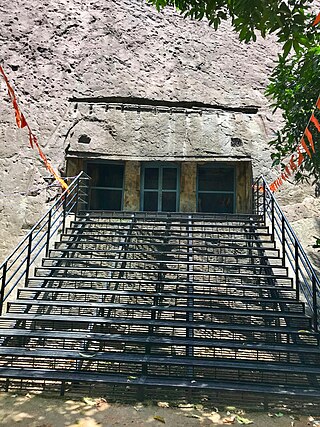
Thirunandikkara Cave Temple, also referred to as Thirunanthikarai rock-cut Shiva temple, is a 9th-century rock-cut Hindu cave temple in Kanyakumari district, Tamil Nadu, India. It is dedicated to Shiva, with murals and inscriptions. It is attributed to the Ay king Vikramaditya Varaguna by Archaeological Survey of India, but to Pandya rulers (Nedunjadaiyan) a few decades earlier by Ajit Kumar, an archaeologist. It is part of a larger active temple complex named the Thirunanthikarai Shri Nandeeswara temple, Thirunanthikarai and is carved out of the side of a rocky hillock to the north of the temple complex. According to Rao, one of the inscriptions suggests that this may be a late 8th-century cave temple or early 9th.
Vatteluttu, popularly romanised as Vattezhuthu, was a syllabic alphabet of south India and Sri Lanka used for writing the Tamil and Malayalam languages.

Kulasekhara, one of the twelve Vaishnavite alvars, was a bhakti theologian and devotional poet from medieval south India (Kerala). He was the author of Perumal Tirumoli in Tamil and "Mukundamala" in Sanskrit. The Perumal Tirumoli, whose second decade is known as "Tetrarum Tiral", is compiled as a part of Nalayira Divya Prabandham. The Trikkulasekharapuram Temple in Kodungallur was founded by the Alvar.

Ayilyam Thirunal Rama Varma (1832–1880) was the ruler of the princely state of Travancore in India from 1860 to 1880. His reign was highly successful with Travancore gaining the appellation of "model state of India". Ayilyam Thirunal was the nephew of Uthram Thirunal and Swathi Thirunal and grandson of Gowri Lakshmi Bayi.

Nagaraja Temple is an early large temple found in the city of Nagercoil (Nagarkōyil) near the southern tip of Tamil Nadu, India. Its dating is uncertain but likely pre-12th-century. The main sanctum is dedicated to the Nagaraja – the king of serpents. Padmanabham (1985), Heritage Of The Tamils Temple Arts, Editors: SV Subramanian and G Rajendran, International Institute of Tamil Studies, Since the 17th-century, new Hindu shrines have been added to the temple complex attracting devotees of Krishna (Vishnu), as well as Shaiva and Shakti Hindus. The original iconography of the Tirthankaras and Padmavati Devi have and continue to remain a part of the sacred pantheon close to the temple's main sanctum.
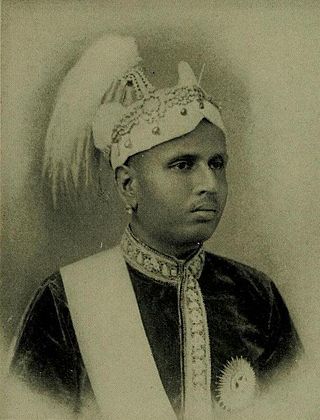
Sir Moolam Thirunal Rama Varma (1857–1924) was Maharajah of the princely state of Travancore between 1885 and 1924, succeeding his uncle Maharajah Visakham Thirunal (1880–1885).

The Vrishnis were an ancient Vedic Indian clan who were believed to be the descendants of Vrishni. It is believed that Vrishni was the son of Satvata, a descendant of Yadu, the son of Yayati. He had two wives, Gandhari and Madri. He has a son named Devamidhusha by his wife Madri. Vasudeva, the father of Krishna was the grandson of Devamidhusha. According to the Puranas, the Vrishnis were residents of Dvaraka.

Ay was one of the Tamil dynasties which controlled the south-western tip of the peninsula, from the early historic period up to the medieval period.The clan traditionally held sway over the harbour of Vizhinjam, the fertile region of Nanjinad, and southern parts of the spice-producing Western Ghat mountains. The dynasty was also known as Kupaka in medieval period.
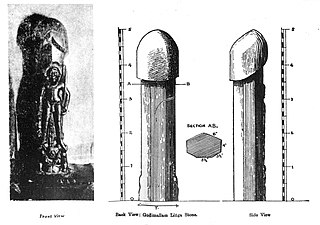
The Gudimallam Lingam is an ancient linga in the Parasurameswara Swamy Temple of Gudimallam, a small village near Tirupati city in the Yerpedu mandal of the Tirupati district of Andhra Pradesh, India. It is situated about 13 kilometers south-east of Tirupati city.

Rama Rajasekhara was a Chera Perumal ruler of medieval Kerala, south India. Rajasekhara is usually identified by historians with Cheraman Perumal Nayanar, the venerated Shaiva (Nayanar) poet-musician of the Bhakti tradition.
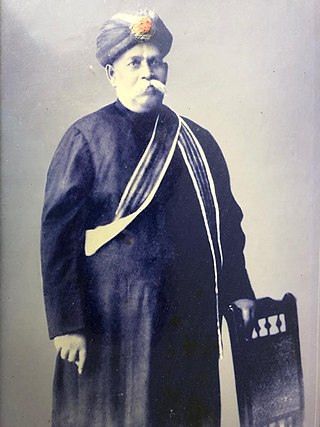
Diwan Bahadur Sir Veeraraghavapuram Nagam Aiya was an Indian pioneer, historian, civil servant, and chronicler who served as the Dewan in the erstwhile princely state of Travancore.
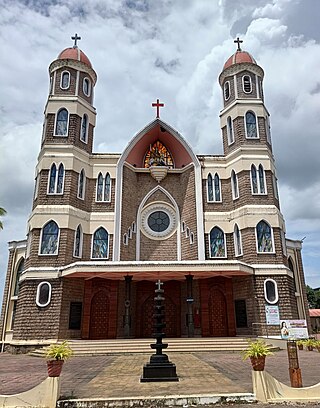
St. George Syro-Malabar Catholic Basilica is a basilica of the Syro-Malabar Catholic Church in Angamaly, Kerala, India. The current basilica building was constructed under the leadership of Paul Kariatty and it was consecrated on 31 December 2006.
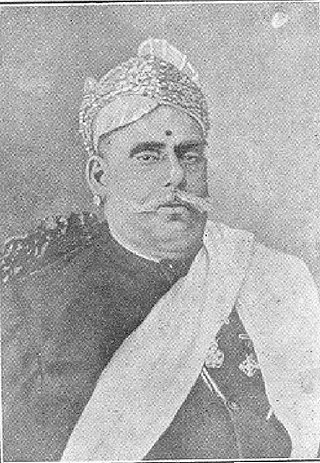
Tanjore Rama Rao, was an Indian administrator who served as the Diwan of Travancore from 1887 to 1892. V. Nagam Aiya, in his 1906 Travancore State Manual calls him "the most popular Diwan in recent times". Rama Rao was a cousin of Rajah Sir T. Madhava Rao and Diwan Bahadur R. Raghunatha Rao. All three were grandsons of Gundopanth. Rama Rao's mother Sonamma Bai was Gundopanth's daughter, while Diwan Bahadur R. Raghunatha Rao's father R. Venkata Rao and T. Madhava Rao's father R. Ranga Rao were Gundopanth's sons.
Kottakkavu Mar Thoma Syro-Malabar Pilgrim Church is a Syro-Malabar church located in North Paravur. According to Saint Thomas Christian tradition, the church was established in 52 AD by St. Thomas, one of the twelve apostles of Jesus Christ. It is one of the first churches in India and is called an Apostolic Church credited to the Apostolate of St. Thomas who preached and also started conversion of people to Syriac Christianity here. It is one of the Ezharappallikal that he established in India; the other six churches were established at Kodungalloor, Kokkamangalam, Palayoor, Kollam, Niranam, and Nilackal.

Vikramaditya —better known as Vikramaditya "Varaguna"—was a monarch of the Ay dynasty of Kerala, south India. His surname indicates that he was a vassal or feudatory of the Pandya ruler Varaguna II. He was the immediate successor of Karunantatakkan "Srivallabha", a vassal of Pandya king Srimara Srivallabha.
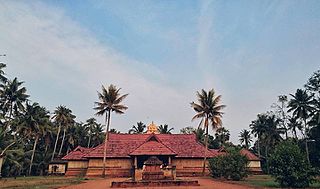
Parthasarathy Temple, also spelled Parthasarathi Temple, is a 9th-century Hindu temple dedicated to Vishnu in Kanyakumari district of Tamil Nadu, India. Spread over 2.5 acres, the temple is notable for the extensive records about it that have been discovered in Huzur Plates of Kollam. The inscriptions on these plates describe how the temple was built along with a salai for 95 students to study the Vedas and other subjects in the Taittiriya, Talavakara and Bhavishya sakhas.